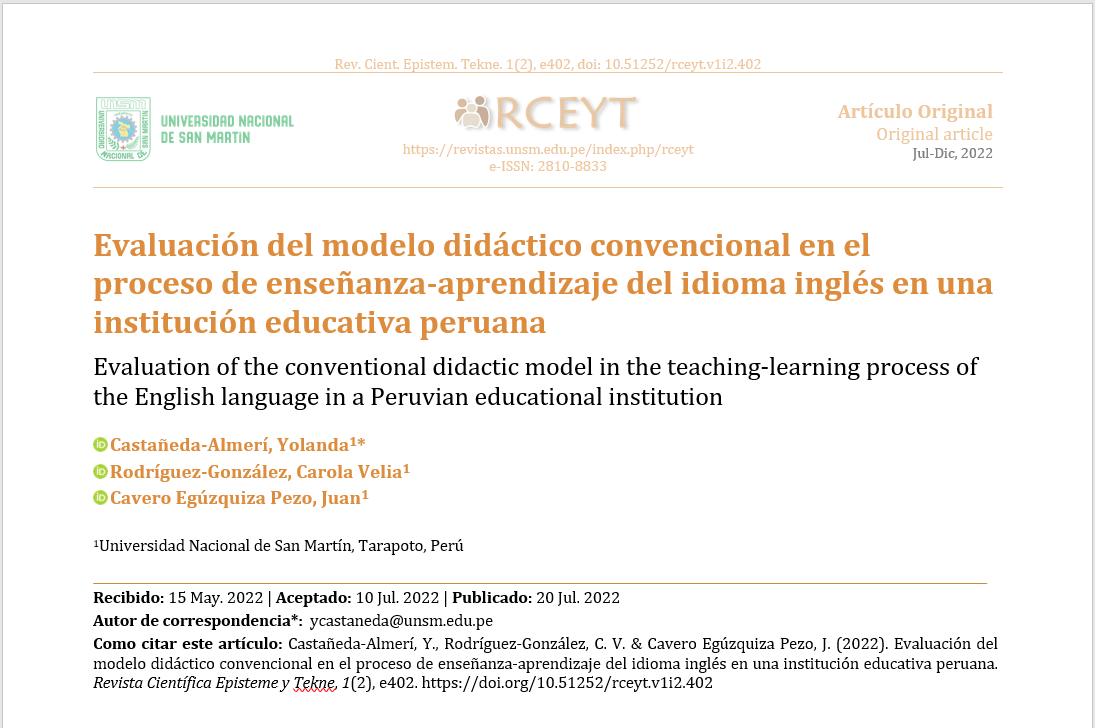Evaluation of the conventional didactic model in the teaching-learning process of the English language in peruvian public educational institutions
DOI:
https://doi.org/10.51252/rceyt.v1i2.402Keywords:
conventional didactic model, teaching model, school performance, second languageAbstract
The development of the cognitive, affective and volitional-actional dimensions seeks to promote the experiential potential of students in the process of learning the English language in educational institutions, however, not applying the appropriate teaching-learning models generate non-significant experiences for the students. The objective of the study was to analyze and evaluate the teaching-learning process of the English language proposed by the Ministry of Education of Peru (MINEDU), applied in public educational institutions. For this, a descriptive, non-experimental, quantitative theoretical study was carried out; the sample consisted of 225 students and 2 english language teachers from a public institution in the district of Tarapoto, to whom an independent questionnaire was applied. The results showed that the methodology taught by the MINEDU on the teaching of the English language presents little motivation and participation of the students. It is concluded that the conventional didactic model does not promote experiential states in students, leaving learning only in the cognitive plane.
Downloads
References
Bárcena, E. (2020). Hacia un nuevo paradigma de aprendizaje de segundas lenguas móvil, abierto y social. Propósitos y Representaciones, 8(1), e460. https://doi.org/10.20511/PYR2020.V8N1.460
Beltrán, M. (2017). El aprendizaje del idioma inglés como lengua extranjera. Revista Boletín Redipe, 6(4), 91–98. https://doi.org/10.36260/RBR.V6I4.227
Bloemert, J., Paran, A., & Jansen, E. (2020). Connecting students and researchers: the secondary school student’s voice in foreign language education research. Cambridge Journal of Education, 50(4), 429–449. https://doi.org/10.1080/0305764X.2020.1720603
García Ponce, I., Vecorena Sánchez, N., & Velasco, E. (2019). El nivel de inglés alcanzado en quinto grado de secundaria en tres colegios públicos de Lima metropolitana. Educación, 28(55), 80–102. https://doi.org/10.18800/educacion.201902.004
Harmer, J. (2007). The practice of english language teaching. Pearson Education.
Huamán Rosales, J. P. (2021). Causas del bajo dominio del idioma inglés en los estudiantes de secundaria de la Educación Básica Regular en el Perú. Lengua y Sociedad, 20(1), 125–144. http://revista.letras.unmsm.edu.pe/index.php/ls/article/view/2206
Luque, B. (2008). Enfoques actuales usados en la enseñanza de segundas lenguas. Letras, 50(76). http://ve.scielo.org/scielo.php?script=sci_arttext&pid=S0459-12832008000100007
Martínez Rizo, F. (2012). La evaluación formativa del aprendizaje en el aula en la bibliografía en inglés y francés: Revisión de literatura. Revista Mexicana de Investigación Educativa, 17(54). http://www.scielo.org.mx/scielo.php?script=sci_arttext&pid=S1405-66662012000300008
Ministerio de Educación del Perú. (2020). Diseño Curricular Básico Nacional de la Formación Inicial Docente : programa de Estudios en Idiomas, especialidad Inglés. http://repositorio.minedu.gob.pe/handle/20.500.12799/6893
Moreno Agurto, V. A. (2020). La importancia de la enseñanza del idioma inglés en la etapa escolar. Alétheia, 8(1), 41–52. https://doi.org/10.33539/ALETHEIA.2020.N8.2422
Moreno Mojica, J. A. (2016). La lingüística cognitiva: una aproximación al abordaje del lenguaje como fenómeno cognitivo integrado*. Análisis. Revista Colombiana de Humanidades, 48(88), 41–51. https://www.redalyc.org/journal/5155/515552626003/html/
Richards, J. C. (2001). Curriculum development in language teaching. Cambridge University Press.
Rivera-Fortty, R. V., Castellano-Noda, A. V., & Loor-Ponce, J. B. (2021). Método comunicativo en la enseñanza del Idioma Inglés en contextos no formales de aprendizaje para desarrollar la expresión oral en estudiantes de Básica Superior de la Escuela Ángel Héctor Cedeño. Polo Del Conocimiento, 6(1), 414–444. https://doi.org/10.23857/PC.V6I1.2151
Romero Zárate, M., & Santana Valencia, E. V. (2021). La afectividad en el aprendizaje del idioma inglés como segunda lengua. Revista Panamericana de Pedagogía, 32. https://doi.org/10.21555/RPP.V0I32.2269
Tipula Mamani, F. M., & Tapia Ccallo, V. V. (2019). Enfoque oral en las programaciones curriculares del curso de inglés en las instituciones educativas de jornada escolar completa. Comuni@cción, 10(1), 57–69. https://doi.org/10.33595/2226-1478.10.1.330
Wang, S., & Littlewood, W. (2021). Exploring students’ demotivation and remotivation in learning English. System, 103, 102617. https://doi.org/10.1016/J.SYSTEM.20
Yanna Kazarián, M. P. R. (2014). Actividades para motivar el aprendizaje de los estudiantes en las clases de Inglés . Revista Habanera de Ciencias Médicas, 13(4). http://www.revhabanera.sld.cu/index.php/rhab/article/view/451
Yi Lin, A. M., & Ocampo, J. M. (2008). Cambios de paradigma en la enseñanza de inglés como lengua extranjera: el cambio crítico y más allá . Revista Educación y Pedagogía, 20(51), 11–23. https://revistas.udea.edu.co/index.php/revistaeyp/article/view/9894
Zierer, E. (2011). Esfuerzos de superar las barreras lingüísticas en la Universidad Nacional de Trujillo . Universidad Nacional de Trujillo. https://isbn.cloud/9789972213175/esfuerzos-de-superar-las-barreras-linguisticas-en-la-universidad-nacional-de-trujillo/

Published
How to Cite
Issue
Section
License
Copyright (c) 2022 Yolanda Castañeda-Almerí, Carola Velia Rodríguez-González, Juan Cavero Egúzquiza-Pezo

This work is licensed under a Creative Commons Attribution 4.0 International License.



